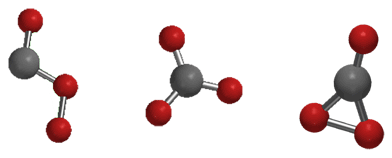Karbon trioksida
Karbon trioksida (CO3) merupakan sebuah produk reaksi tidak stabil dari reaksi antara karbon dioksida (CO2) dengan oksigen atomik (O).[1] Ia berbeda dengan ion karbonat (CO32−). Ia juga telah terdeteksi pada reaksi antara karbon monoksida dengan oksigen O2. Ia juga ditemukan pada zona hanyutan lucutan korona negatif.[2] Karbon trioksida dapat dibuat dari penghembusan ozon pada es kering.

Terdapat tiga bentuk isomer karbon trioksida, ditandai dengan Cs, D3h, dan C2v. Telah ditunjukkan keadaan C2v merupakan keadaan dasar molekul.[1] Diarsipkan 2012-06-30 di Archive.is
Referensi
- Electronic structure and spectroscopy of carbon trioxide Diarsipkan 2012-06-30 di Archive.is
- Sabin J. R., Kim H. (1971). "A theoretical study of the structure and properties of carbon trioxide". Chemical Physics Letters. 11 (5): 593–597. doi:10.1016/0009-2614(71)87010-0.
- Sobek V., Skalný J. D. (1993). "A simple model of processes in the drift region of negative corona discharge in a mixture of air with halocarbons". Czechoslovak Journal of Physics. 43 (8): 807. doi:10.1007/BF01589802. [pranala nonaktif permanen]
- Pople J. A. , Seeger U., Seeger R., Schleyer P. v. R. (2004). "The structure of carbonate". Journal of Computational Chemistry. 1 (2): 199–203. doi:10.1002/jcc.540010215. Pemeliharaan CS1: Banyak nama: authors list (link)
- Moll N. G., Clutter D. R., Thompson W. E. (1966). "Carbonate: Its Production, Infrared Spectrum, and Structure Studied in a Matrix of Solid CO2". The Journal of Chemical Physics. 45 (12): 4469–4481. doi:10.1063/1.1727526. Pemeliharaan CS1: Banyak nama: authors list (link)
- Gimarc B. M., Chou T. S. (1968). "Geometry and Electronic Structure of Carbon Trioxide". The Journal of Chemical Physics. 49 (9): 4043–4047. doi:10.1063/1.1670715.
- DeMore W. B., Jacobsen C. W. (1969). "Formation of carbon trioxide in the photolysis of ozone in liquid carbon dioxide". Journal of Physical Chemistry. 73 (9): 2935–2938. doi:10.1021/j100843a026.
- DeMore W. B., Dede C. (1970). "Pressure dependence of carbon trioxide formation in the gas-phase reaction of O(1D) with carbon dioxide". Journal of Physical Chemistry. 74 (13): 2621–2625. doi:10.1021/j100707a006.
- Francisco J. S., Williams I. H. (1985). "A theoretical study of the force field for carbon trioxide". Chemical Physics. 95 (3): 373. doi:10.1016/0301-0104(85)80160-9.











